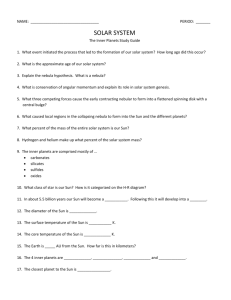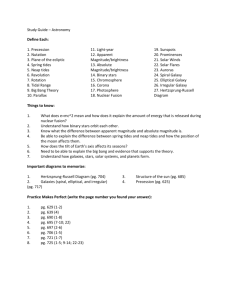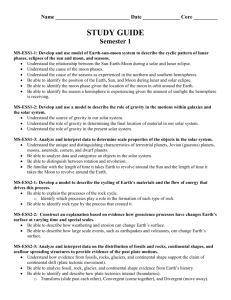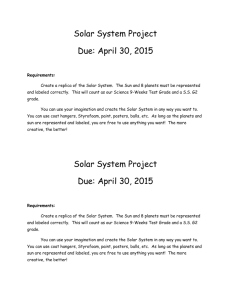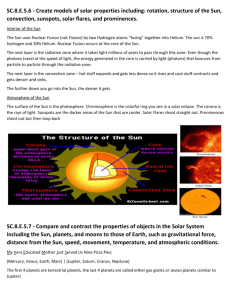long term project Benchmarks
advertisement
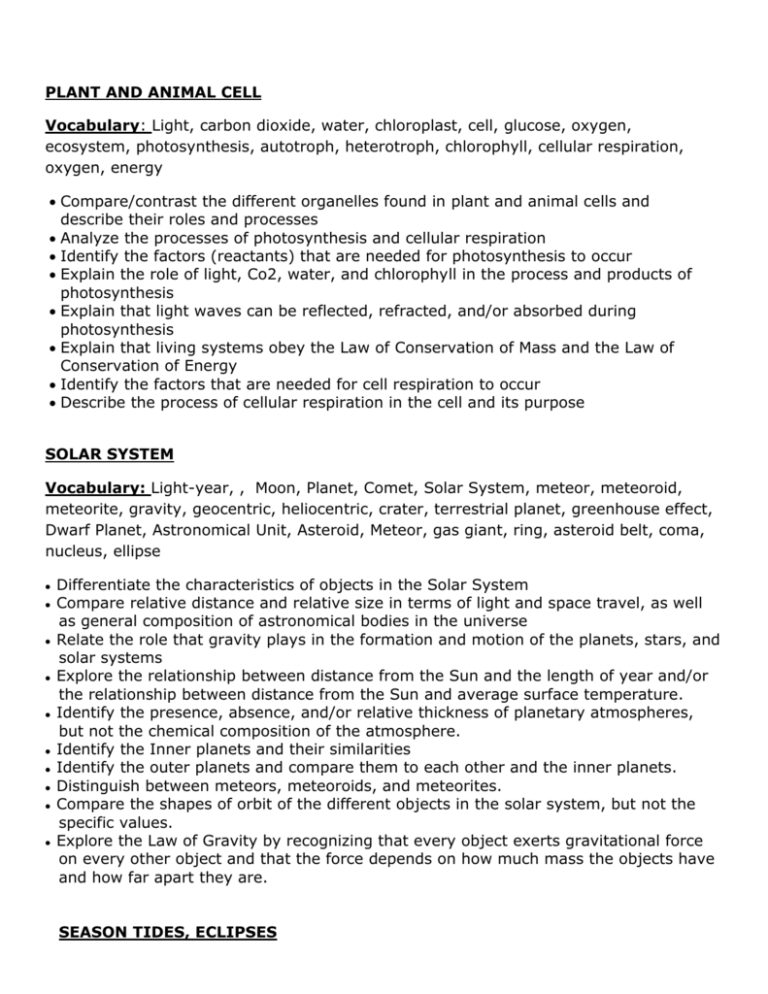
PLANT AND ANIMAL CELL Vocabulary: Light, carbon dioxide, water, chloroplast, cell, glucose, oxygen, ecosystem, photosynthesis, autotroph, heterotroph, chlorophyll, cellular respiration, oxygen, energy Compare/contrast the different organelles found in plant and animal cells and describe their roles and processes Analyze the processes of photosynthesis and cellular respiration Identify the factors (reactants) that are needed for photosynthesis to occur Explain the role of light, Co2, water, and chlorophyll in the process and products of photosynthesis Explain that light waves can be reflected, refracted, and/or absorbed during photosynthesis Explain that living systems obey the Law of Conservation of Mass and the Law of Conservation of Energy Identify the factors that are needed for cell respiration to occur Describe the process of cellular respiration in the cell and its purpose SOLAR SYSTEM Vocabulary: Light-year, , Moon, Planet, Comet, Solar System, meteor, meteoroid, meteorite, gravity, geocentric, heliocentric, crater, terrestrial planet, greenhouse effect, Dwarf Planet, Astronomical Unit, Asteroid, Meteor, gas giant, ring, asteroid belt, coma, nucleus, ellipse Differentiate the characteristics of objects in the Solar System Compare relative distance and relative size in terms of light and space travel, as well as general composition of astronomical bodies in the universe Relate the role that gravity plays in the formation and motion of the planets, stars, and solar systems Explore the relationship between distance from the Sun and the length of year and/or the relationship between distance from the Sun and average surface temperature. Identify the presence, absence, and/or relative thickness of planetary atmospheres, but not the chemical composition of the atmosphere. Identify the Inner planets and their similarities Identify the outer planets and compare them to each other and the inner planets. Distinguish between meteors, meteoroids, and meteorites. Compare the shapes of orbit of the different objects in the solar system, but not the specific values. Explore the Law of Gravity by recognizing that every object exerts gravitational force on every other object and that the force depends on how much mass the objects have and how far apart they are. SEASON TIDES, ECLIPSES Vocabulary: axis, rotation, revolution, calendar, solstice, equinox, phase, eclipse, solar eclipse, umbra, penumbra, lunar eclipse, tide, spring tide, neap tide Identify the effects of the Sun on the Earth including seasons and gravitational attraction Explain the relationship between the Moon and the Earth, including phases, tides, and eclipses, and the relative position of each body. Distinguish between rotation and revolution. Explain the causes of the cycle of seasons on Earth. Distinguish between solstices and equinoxes. Explain the causes of moon phases. Describe solar and lunar eclipses. Explain what causes tides. Describe the effects of different moon phases on tides. Distinguish between spring tides and neap tides. GENETICS/ Heredity Describe and/or explain that every organism requires a set of instructions that specifies its traits. Identify and/or explain that hereditary information (DNA) contains genes located in the chromosomes of each cell and/or that heredity is the passage of these instructions from one generation to another. Explain and teach the class how to complete a Punnett squares and pedigrees to determine genotypic and phenotypic probabilities. Compare and/or contrast general processes of sexual and asexual reproduction that result in the passage of hereditary information from one generation to another Compare and contrast meiosis and mitosis. LANDFORMS & Human Impact Explain the variety of different landforms on Earth’s surface such as coastlines, dunes, rivers, mountains, glaciers,deltas, and lakes and relate these landforms as they apply to Florida. Describe similarities and/or differences among landforms found in Florida and those found outside of Florida Identify the impact that humans have had on the different landforms mentioned above and on Earth, such as deforestation, urbanization, desertification, erosion, air and water quality, and changing the flow of water LAYERS OF THE EARTH theory of plate tectonics by describing how the movement of Earth’s crustal plates causes both slow and rapid changes in Earth’s surface, including volcanic eruptions, earthquakes, and mountain building Describe the layers of the solid Earth, including the lithosphere, the hot convecting mantle, and the dense metallic liquid and solid cores. Recognize that heat flow and movement of material within Earth causes earthquakes and volcanic eruptions, and creates mountains and ocean basins. Explain the density differences between layers of the earth ROCKS & ROCK Cycle Identify and/or describe steps of the rock cycle and then relate them to surface events (weathering and erosion) and subsurface events (plate tectonics and mountain building). Describe and give examples of ways in which Earth’s surface is built up and torn down by physical and chemical weathering, erosion, and deposition. Explain terms, such as aquifers, caverns, and/or sinkholes WEATHER & CLIMATE Investigate and apply how the cycling of water between the atmosphere and hydrosphere has an effect on weather patterns and climate. Describe how global patterns such as the jet stream and ocean currents influence local weather in measurable terms such as temperature, air pressure, wind direction and speed, and humidity and precipitation. Differentiate between weather and climate. Explain interactions among the geosphere, hydrosphere, cryosphere, atmosphere, and biosphere. Explain the layers of the atmosphere and/or the function of each layer Measuring the Age of the Earth Identify current methods for measuring the age of Earth and its parts, including the law of superposition and radioactive dating. Explain Fossil records Address folding and faulting as related to the law of superposition. FORMS of ENERGY On EARTH Explain how energy provided by the Sun influences global patterns of atmospheric movement and/or the temperature differences among air, water, and land. Differentiate among radiation, conduction, and convection in Earth’s atmosphere, hydrosphere and geosphere . Explain what causes wind and wind patterns Identify, compare, and/or contrast the variety of types of radiation present in radiation from the Sun. Identify and/or compare characteristics of the electromagnetic spectrum. Identify common uses and/or applications of electromagnetic waves.



